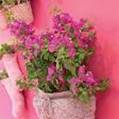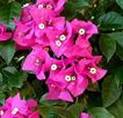| Kingdom | Plantae |
| Division | Magnoliophyta |
| Class | Magnoliopsida |
| Order | Caryophyllales |
| Family | Nyctaginaceae |
| Genus | Bougainvillea |
| Species | B. glabra |
| Binomial name | Bougainvillea glabra |
Other Common Names:
The other common names for the plant bougainvillea are paper flower and lesser bougainvillea.
History


Bougainvilleas are perhaps the most popular and one of the most widely grown tropical vines. A native to the coast of Brazil. In the 1760's the French botanist Philibert Commerson discovered the colourful vining plant and named it bougainvillea after his friend and captain, Louis A. de Bougainville, a noted lawyer, mathematician, and explorer from Canada. It is one of the most common species used for bonsai. There are some places in the United States that have named this beautiful flower as their official flower.
Places in southern California as well as the Philippines honour this plant. The bougainvillea is a tropical member of the Nyctaginaceae family. With more about 30 genera and 300 over species, the members of this family are mostly herbs, shrubs and trees. The bougainvillea can be a shrub shaped to provide barrier in the form of hedges or topiaries, or a climber which adds interest to lamp posts, trees and trellises.
Description


Range
This flowering plant is a native to South America from Brazil west to Peru and south to Southern Argentina and generally thrives in tropical climate.
Habitat
Bougainvillea will thrive in almost any soil as long as it is well-drained and fertile. The bougainvillea provides barrier in the form of hedges or topiaries, or a climber which adds interest to lamp posts, trees and trellises. Some planted along the overhead bridges and window boxes cascade downwards like a bridal bouquet providing beauty to the otherwise plain structure.
Cultivation
Growing season requires 60 degrees or warmer. This makes it difficult for people in colder climates to get the maximum ornamental value of Bougainvillea unless it is greenhouse grown during winter months. Bougainvillea's foliage is temperature sensitive below 50 degrees but the plant will survive down to the mid 30's with leaf drop. Plants have been in an almost dark garage over winter and they have survived and defoliate the following spring. When doing this, cut all fertilization and greatly reduce watering. An other way of recommend growing Bougainvillea as a hanging basket plant. That makes it easy to take in and out as temperatures fluctuate. Remember to acclimatize any plant to lower light levels by gradual reduction of light if attempting to over winter in lower light conditions. It loves to be pruned occasionally which actually encourages new growth and therefore more potential bloom. We haven't really figured out the best fertilization program for them but have noticed that several sources have recommended a formulation similar to Hibiscus formulations of approximately 15-5-10. Flowering is best forced by letting the plant dry to the point foliage shows wilting before watering thoroughly. This helps encourage the plant to bloom through stress reaction. Bougainvillea must receive full sunlight or bright light and must be grown in a well drained soil as it must be grown on the dry side. A flowering fertilizer or organic fertilizers such as chicken waste and goats waste are excellent to induce blooming. If you want good blooming give them at least 5 hours a day of full sunlight as a minimum. More hours of direct sun are better.
Flowering Season
The inconspicuous white and small flowers are in bloom through out the year in warm climates and the flowering cycles are typically four to six weeks.
Pests and Diseases
Mostly the plant is pest free but at times suffers from worms and aphids. The larvae of some lepidoptera species like Giant leopard moth also use them as food plants. In cold weathers they are also affected by caterpillars, mites, aphids and leaf spot.
Parts Used
The plant is said to have no medicinal or commercial applications but it is only of ornamental value.
Uses

• Bougainvillea has no medicinal or culinary application. However this fast growing vine is used as a screen or a hedge plant and it is of more of ornamental value.
• It is also used in flower baskets and bouquets.
• It can be kept as indoor houseplants in temperate regions and also they can be kept small by bonsai techniques.
• The Bougainvillea has traditionally been used outdoors on a patio or other locations.
• Today these beautiful plants have a new location to call home.
• They can be just as happy inside a home as they are outside.


Bougainvillea is said to be the national flower of Lienchiang country.
Various species of bougainvillea are the official flowers of the island of Grenada, the island of Guam, of Lienchiang and Pingtung Counties in Taiwan, Ipoh, Malaysia and of the cities of Tagbilaran, Philippines; Camarillo, California; Laguna Niguel, California; and San Clemente, California.